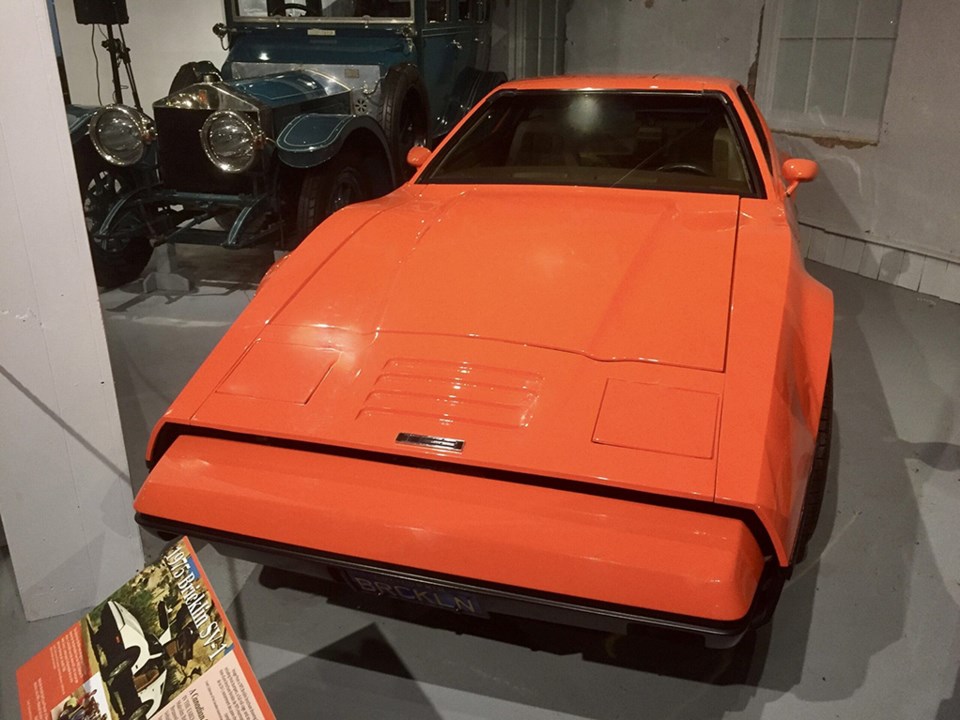It was 50 years ago this month that one of the most colourful, unusual, and unlikely chapters in automotive history officially began with the launch of the Bricklin. On August 6, 1974, the first Bricklin came off the assembly line in Saint John, New Brunswick.
The Bricklin, a gullwing, fibreglass safety sports car aimed at the Corvette, was created by an American entrepreneur, Malcolm Bricklin. The Bricklin SV-1 (for “safety vehicle”) emphasized safety, and surpassed federal standards. There wasn’t even a cigarette lighter or ashtray because Bricklin thought it wasn’t safe to smoke and drive – an unusual viewpoint in the early 1970s.
Corporate offices were in Scottsdale, Arizona, and engineering facilities were in a suburb of Detroit.
When it came time to find a place to build the cars, Malcolm Bricklin teamed up with Premier Richard Hatfield of New Brunswick, who wanted to create jobs in his province – and was willing to provide millions of dollars to attract the fledgling automaker.
Neighbouring Nova Scotia had been home to a Volvo assembly plant for more than a decade, and here was a chance for New Brunswick to also be part of the auto industry.
In June 1973, Hatfield announced the New Brunswick government would become a 51 per cent owner of Bricklin for $500,000 and provide loan guarantees of $2.9 million.
There were plans to manufacture 10,000 to 12,000 vehicles per year.
Bricklin established operations in Minto and Saint John with plans to start car production in September 1973. However, the process faced multiple delays when he realized that launching a car company was more costly and time-consuming than he had initially expected.
In May 1974, Bricklin received another $1.2 million from the New Brunswick government and a $3 million loan guarantee from the federal government. Premier Hatfield said, “Sure, it’s a high-risk venture. It’s time someone in Canada took a chance. We Canadians are very conservative.”
The Bricklin officially debuted at a news conference on June 25, 1974, in New York. It received plenty of praise from major car magazines for its performance, safety features, and sexy looks, including the gullwing doors, which opened with hinges on the roof.
Finally, on August 6, 1974, the official opening ceremonies were held in Saint John, when Malcolm Bricklin drove the first Bricklin, a bright orange model, off the assembly line. His passenger was Premier Hatfield.
Malcolm Bricklin soon needed more money to improve quality control and increase production.
In December 1974, the government gave Bricklin another $1 million in exchange for 67 per cent equity in the company. A few weeks later, Hatfield announced an additional $2.5 million in financing.
In January, the premier announced another $7.5 million, bringing the total federal and provincial funding to $23 million.
By mid-March, Bricklin had shipped 1,000 cars to 247 dealerships in 14 northeastern states. By then the price, originally set at $7,485, had risen to $9,980.
Despite all of the government funds, the automaker required even more money. But on September 25, Hatfield refused to provide further support and decided to put Bricklin into receivership. As a result, 700 people lost their jobs.
In total, about 2,800 Bricklins were produced.
Many Canadians proudly embraced the Bricklin. The Royal Canadian Mint issued a $20 gold coin with the Bricklin on it, and a Bricklin was on a new Canadian stamp. A record called the Bricklin made it to number 17 on the country charts. Later, there was a musical play about the Bricklin called The Bricklin: An Automotive Fantasy. The Bricklin story is told in the book by Dimitry Anastakis, which was released earlier this year.
In an interview a few years ago, Malcolm Bricklin told me, “The best part was how hard the people worked on the project and how deeply they threw themselves into it. Premier Hatfield was very sharp, very smart and very hard-working. He wanted to figure out how to make his province better for his people.”
The impact of the Bricklin has lasted far longer than the car did.
Seeking financial support from governments was unheard of in North America at the time, raising questions about the role of governments in bankrolling car companies. But now it’s standard procedure for automakers to ask for government incentives when looking for a site for a new assembly plant. No one imagined back then that the U.S., Canadian and Ontario governments would later become part-owners of General Motors when it was in financial trouble in 2008-2009.
Bricklin also made an impact on the industry by building cars in New Brunswick, a relatively remote area, at a time when most cars were manufactured in traditional auto industry hubs like Michigan, Ohio, and Ontario. Following Bricklin’s example, new auto plants have since been established in regions far from these traditional centres, including Alabama, Georgia, Kentucky, 小蓝视频 Carolina, and Tennessee.
The Bricklin was the only successful automotive start-up in North America since the end of the Second World War until the Tesla was introduced earlier this century.
No one knew that, when that first Bricklin rolled off the assembly line half a century ago in Saint John, New Brunswick, many of the approaches and concepts used by Bricklin would become commonplace among major automakers in the decades to come.
Dale Johnson is an award-winning author, broadcaster and journalist who has worked in TV, radio, print and online.
©




